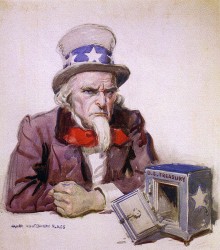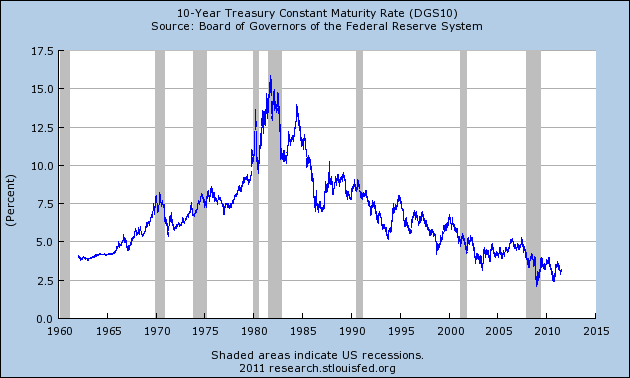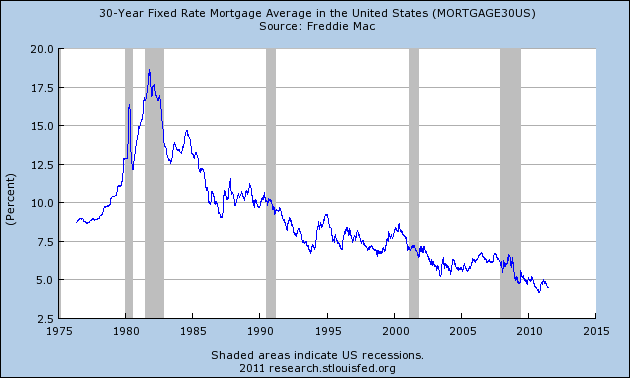 Right now, interest rates are near historic lows. The U.S. government is able to borrow gigantic mountains of money for next to nothing. U.S. consumers are still able to get home loans, car loans and student loans at ridiculously low interest rates. When this low interest rate environment changes (and it will), it is going to absolutely devastate the U.S. economy. Without low interest rates, the U.S. financial system dies. When it comes to borrowing money, it is the rate of interest that causes the pain. If you could borrow as much money as you wanted at a zero rate of interest for the rest of your life you would never, ever have a debt problem. But when there is a cost to borrowing money that changes things. The higher the rate of interest goes, the more painful debt becomes.
Right now, interest rates are near historic lows. The U.S. government is able to borrow gigantic mountains of money for next to nothing. U.S. consumers are still able to get home loans, car loans and student loans at ridiculously low interest rates. When this low interest rate environment changes (and it will), it is going to absolutely devastate the U.S. economy. Without low interest rates, the U.S. financial system dies. When it comes to borrowing money, it is the rate of interest that causes the pain. If you could borrow as much money as you wanted at a zero rate of interest for the rest of your life you would never, ever have a debt problem. But when there is a cost to borrowing money that changes things. The higher the rate of interest goes, the more painful debt becomes.
The only reason that U.S. government finances have not fallen apart completely already is because the federal government is still able to borrow huge amounts of money very cheaply. If interest rates on U.S. government debt even return just to "average" levels, it is going to be absolutely catastrophic.
So what happens if rates go above "average"?
The reality is that if there is a major crisis that causes interest rates on U.S. Treasuries to go well beyond "normal" levels it is going to cause a complete and total collapse.
In 2010, the U.S. government paid out just $413 billion in interest even though the national debt soared to 14 trillion dollars by the end of the year.
That means that the U.S. government paid somewhere in the neighborhood of 3 percent interest for the year.
Considering how rapidly the U.S. dollar has been declining and how much money printing the Federal Reserve has been doing, a rate of interest that low is absolutely ridiculous.
The shorter the term, the more ridiculous the rates of interest on U.S. Treasuries are.
For example, the rate of interest on 3 month U.S. Treasuries right now is just barely above zero.
The Federal Reserve has been playing all kinds of games in an attempt to keep interest rates on U.S. government debt low, and so far they have been pretty successful at it.
But they aren't going to be able to do it forever.
Up until now, other nations and investors around the world have continued to participate in the system even though they know that the Federal Reserve is cheating.
However, there are signs that a lot of investors are finally getting fed up and are ready to walk away from U.S. government debt.
China has been dumping short-term U.S. government debt. Russia has been dumping U.S. government debt. Pimco has been dumping U.S. government debt.
Others are taking things even farther.
In fact, there are some investors that plan on cashing in on the loss of confidence in U.S. Treasuries. Renowned investor Jim Rogers says that he is now going to be shorting 30 year U.S. government bonds.
Just check out what Rogers recently told CNBC....
"I cannot imagine or conceive lending money to the United States government for 30-years at 3, 4, 5 or 6 percent —you pick a number — in U.S. dollars"
And he is right. Who in the world would be stupid enough to loan the U.S. government money at a 4 or 5 percent rate of interest for the next 30 years?
Actually, most U.S. government debt is financed in the short-term these days. In fact, the U.S. government issues a higher percentage of short-term debt than any other industrialized nation.
This trend really got started during the Clinton administration. Back then they figured out that the U.S. could reduce its borrowing costs substantially by relying much more heavily on short-term debt. The Bush and Obama administrations have continued this trend.
So these days the U.S. government constantly has huge amounts of debt that are maturing and that need to be rolled over.
This is great as long as interest rates stay very, very low.
But when interest rates rise the whole game will change.
In a recent article, Pat Buchanan explained that the Obama administration is being completely unrealistic when it assumes that interest rates on U.S. government debt will stay incredibly low over the next decade....
"The average rate of interest the Fed has had to pay to borrow for the last two decades has been 5.7 percent. However, President Obama is projecting the cost of money at only 2.5 percent.
A return to the normal Fed rate would, by 2020, add $4.9 trillion to the cumulative deficit"
Most Americans really cannot grasp how incredibly low interest rates are right now.
Sometimes a picture is worth a thousand words.
The following chart shows how interest rates on 10 year U.S. Treasury bonds have declined over the last several decades.
As confidence in the U.S. dollar and in U.S. government debt declines, interest rates will go up.
In fact, there are troubling signs that we are starting to see a move in that direction right now. Last week, the yield on 5 year U.S. Treasuries experienced the biggest one week percentage jump ever recorded.
The big danger is that the political wrangling in Washington D.C. will start to cause a panic. The managing director of Standard & Poor's recently told Reuters that if the U.S. government starts defaulting on debt at the beginning of August, the credit rating on U.S. Treasury bonds that are supposed to mature on August 4th will go from AAA all the way down to D....
Chambers, who is also the chairman of S&P's sovereign ratings committee, told Reuters on Tuesday that U.S. Treasury bills maturing on August 4 would be rated 'D' if the government fails to honor them. Unaffected Treasuries would be downgraded as well, but not as sharply, he said.
"If the U.S. government misses a payment, it goes to D," Chambers said. "That would happen right after August 4, when the bills mature, because they don't have a grace period."
When a credit rating gets slashed, interest rates on that debt can go up dramatically.
Just ask the citizens of Greece.
Today, the interest rate on 2 year Greek bonds is over 26 percent.
You are delusional if you believe that something like that can never happen here.
Right now the U.S. national debt is completely and totally out of control. If the U.S. government had to start paying interest rates of 10, 15 or 20 percent to borrow money it would be a total nightmare.
This year the U.S. government will have income of about 2.2 trillion dollars.
If in future years the U.S. government is spending a trillion or a trillion and a half dollars just on interest on the national debt, then how in the world is it going to be possible to even run the government, much less balance the budget?
But rising interest rates would not just devastate the federal government.
It would become much more expensive for state and local governments to borrow money.
Student loans would become much more expensive.
Car loans would become much more expensive.
Home loans would become out of reach for everyone except the very wealthy.
As we saw during the housing crash of a few years ago, rising interest rates can absolutely wipe homeowners out.
On a standard home loan, if you change the rate of interest from 5 percent to 10 percent you increase the mortgage payment by approximately 50 percent.
If you change the rate of interest from 5 percent to 15 percent, you roughly double the mortgage payment.
As the 30 year fixed rate mortgage chart below shows, interest rates are near historic lows right now....
Keep in mind that even with such ridiculously low interest rates the U.S. real estate market has been deader than a doornail.
So what would a significant spike in interest rates do to it?
When all of these low interest rates go away the entire financial system is going to change dramatically.
A significant spike in interest rates would wipe out U.S. government finances, it would push state and local governments all over the country to the brink of bankruptcy, it would bring economic activity to a standstill and it would destroy any hopes for a housing recovery.
This country, and in particular the federal government, is enslaved to debt but right now we are not feeling the full pain of that debt because interest rates are so low.
If you want to know when things are really going to start coming apart, just keep an eye on interest rates. When they really start spiking you can start sounding the alarm.
The truth is that the state of the economy is going to continue to get worse. Our debt is growing every single day and our country is getting poorer every single day. When interest rates start surging it is going to start knocking over a lot of dominoes.
I hope you are getting prepared for when that happens.
© 2024 Benzinga.com. Benzinga does not provide investment advice. All rights reserved.
Comments
Trade confidently with insights and alerts from analyst ratings, free reports and breaking news that affects the stocks you care about.


